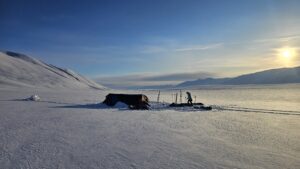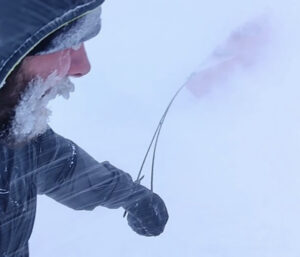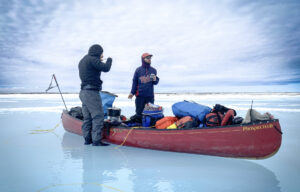Once upon an earlier time, I was doing ethnographic work in the village of Angmagssalik (now Tasiilaq), East Greenland. As a respite from sitting down and recording the stories of elders, I went with a local Inuk for a hike on the tundra just outside the village. As a further respite, I began looking for mushrooms while we were hiking.
Contrary to what you might think, Greenland boasts a plethora of mushrooms, indeed five times as many mushroom species as it has species of vascular plants. We soon saw an example of this plethora — a colorful carpet of red Russulas, yellowish Amanitas, and purple Cortinarius more or less at our feet.
I reached down to pick a mushroom I didn’t recognize and peer at it through my hand lens. “Naamik!” shouted my companion, then he added: “Do not touch.” There was a worried look on his face.
Might the fellow have been displaying a prejudice against mushrooms commonly found among certain Inuit groups? An example: the Inuit in the Central Canadian Arctic believe mushrooms are the anaq (shit) of shooting stars. In the fall, a shooting star will race across the night sky, leaving a trail of detritus behind it, and the following morning mushrooms have appeared on the ground. Obviously, those mushrooms are the anaq of the shooting stars, and no less obviously, they are flagrantly inedible.
“Do not touch because it’s anaq?” I asked my guide, pointing to the mushroom in question.
He shook his head. “Qivittoq sopa,” he explained.
From the time I’d spent in Greenland, I knew about qivittut. They were monstrous beings who lived in the mountains and regarded us humans as prime edibles. A qivittoq will fly into a village, grab a person, and immediately scarf down that person. Or it’ll fly its prey back to its mountain home for later consumption. Several houses in Angmagssalik were unoccupied at the time of my visit because a qivittoq had flown into them in search of human cuisine. The houses were empty because they were now thought to be qivittoq property.
But qivittoq sopa? “Paasinnagilara,” I declared to my companion. Which means “I don’t get it.” After all, the word for mushroom in West Greenland is pupik or, if the person is a speaker of Danish, svamp.
Before I offer you my companion’s explanation, I should mention that many Arctic mushrooms — indeed, many mushrooms in temperate regions as well — have a coating of slime on them. This slime is a sort of anti-freeze that helps them survive in cold weather. The mushroom I was getting ready to pick was probably a Hygrocybe, otherwise known as a waxy cap. ‘Waxy’ is a nice word for ‘slimy.’
Now for the explanation. Qivittut smell bad, really bad, my companion told me, and they need to wash themselves lest they give away their presence to us. They do this washing with the slime from mushrooms, lathering themselves all over with it. You wouldn’t want to touch, much less eat something that a qivittoq bathes with, would you? What’s more, if a qivittoq finds out you’re collecting its cleansing agent, more than likely it’ll come calling, and you’ll be lucky if you escape with your life.
Greenlanders often use Danish if they want to utter some sort of insult. I now decided to do so as well. “Ga ad helvede til, din fjola!” I said to the mushroom I’d been getting read to pick. Which means “Go to hell, you bugger!”
My companion grinned. Whether this was because he thought my remark was amusing or whether he too wanted the mushroom to go to hell, I have no idea.
For the rest of the hike, I neither touched nor picked any mushrooms. Tundra blueberries, yes; but not a single mushroom. For I wanted to show my respect for my companion’s culture. What’s more, I wanted to preserve a conviction that goes back, far back, in time.






